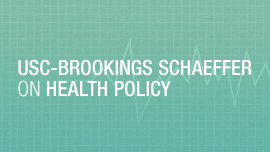As the biological basis of more diseases are fully revealed, and the drugs targeting medical problems become more focused and effective, more patients are finding themselves on costlier specialty medicines. At the same time, consumers find themselves paying a growing portion of their drug bills out of pocket as the structure of insurance changes. These two developments have combined to result in significant consumer hardship.
In response to these trends, there has been political pressure to enact policies giving federal and state governments authority to set drug prices or limit price increases. However, these policies could have the unintended consequence of reducing the incentive to develop more effective drugs.
In Europe, government price-setting authorities systematically overpay for some older, less innovative drugs while reducing the prices of and access to newer, more significant breakthroughs. Many worry that enacting a similar policy in the United States would reduce the profitability of new, innovative research endeavors.
We believe that certain regulatory reforms can address these concerns and encourage more robust competition within the drug market. These policies would allow prices to more easily adjust to reflect how medicines are prescribed and the outcomes they deliver, and thus would help control rising spending and reduce the burden of drug costs for consumers. One way to make drug pricing more competitive is to implement selling models that tie the price of drugs more closely to the usefulness of the clinical setting in which they are being prescribed. However, existing regulations obstruct this type of market-oriented approach.
Pricing Based On Indication And Outcomes
The Centers for Medicare and Medicaid Services (CMS) recently announced that as early as 2017, it plans to pursue changes in the way Medicare pays for injectable drugs under its Part B program to give drug makers more flexibility to price products based on indications and outcomes. Yet the Medicare program left open how the relative value of different indications would be determined. Would drug makers be free to vary prices based on clinical demand and the benefits being offered in different clinical settings? Or as the rule suggests, will CMS try to influence these conclusions with an assessment of clinical value?
CMS’ proposed rule also does not address several challenges associated with a value-based pricing framework. For example, the proposal did not address the small molecule drugs that are the focus of much of the price scrutiny, only injectable drugs paid for as part of the medical benefit. Moreover, enabling such a framework for value-based pricing would require simultaneous regulatory reforms at the Food and Drug Administration (FDA), as well as the Office of the Inspector General. Because the impediments to this sort of policy effort cut across multiple agencies, it will likely require a legislative remedy to fully enable.
Inside CMS, enabling drug makers to adjust prices based on the purpose for which medicines are being prescribed will require changes to the existing rules that govern drug pricing. For example, federal regulators will need to relax the way that they implement current price-setting constructs like the calculation for Medicaid best price, the ceiling price for the 340B program, and the reporting rules for Medicare’s Part B average sales price. These rules complicate the ability of companies to price the same drug differently, based on how it’s being prescribed, or to enter into “value-based’ contracts that tie drug prices and discounts to measures of how a population of patients benefit from a given treatment.
Take, for example, the Medicaid Best Price rules. Best price is the lowest manufacturer price paid for a drug by any purchaser. It’s defined by the Medicaid statute as “any wholesaler, retailer, provider, health maintenance organization, or nonprofit or government entity” with some exceptions (Note 1). In short, it’s the cheapest price at which a drug is sold. A drug’s reported best price is required to reflect all discounts, rebates, and other pricing adjustments. It’s the benchmark that the government uses to make sure that state Medicaid programs are receiving the lowest price for which a drug is being offered to any purchaser.
Under these rules, if a drug maker enters into a contract with a private health plan to discount a drug based on how it’s being used (or the clinical results that it achieves) then the discount that’s offered when the drug is used in settings that are judged to yield less value would become the new benchmark for calculating the Medicaid best price. The rebates offered to a private insurer under the terms of just one value-based contract would establish the new price offered to all Medicaid programs, regardless of whether or not the Medicaid plans were also entering into similar contracting arrangements. So Medicaid plans that did not contract to pay higher prices when drugs were used in certain higher value settings, and lower prices when they were prescribed for lower value indications, would nonetheless pay a price for all of their prescriptions that reflected the lowest price offered under a value-based arrangement. This new Medicaid price could, in turn, influence other price schedules.
Consider a drug maker that offered a 90 percent discount on a drug when it didn’t produce any of its expected benefit. Under current rules, that deeply discounted price would become the new Medicaid best price, but not necessarily the blended price that reflects the average price being paid under a contract where the price fluctuated based on how a drug was being prescribed. This could create a significant disincentive for manufacturers to offering indication and outcome-based prices. For these reasons, enabling drug makers to adjust prices based on these parameters will require changes to rules on how drug makers must track and report prices to the government under Medicaid and to the 340B drug program.
Similar challenges to value-based pricing are posed by Medicare’s calculation of average sales price (ASP) as part of its framework for reimbursing injectable drugs paid under Part B. The ASP is defined as a manufacturer’s sales of a drug to all U.S. purchasers in a calendar quarter divided by the total number of units of the drug sold by the manufacturer in that same quarter (Note 2). The ASP is net of any price concessions, such as volume discounts, prompt pay discounts, cash discounts, free goods contingent on purchase requirements, chargebacks, and rebates other than those obtained through the Medicaid drug rebate program.
Manufacturers that offer discounts under commercial, value-based contracts would probably face reductions in their calculated ASP as a result of the concessions. In turn, they would see their reimbursement under Medicare Part B also decline, regardless of whether Medicare entered into the same outcome or indication-based contracts. Since the private market pegs its own pricing off of the ASP, a single value-based contract that served to lower the ASP could have the effect of reducing a drug maker’s reimbursement across every other contract. For drug manufacturers, this is another disincentive to entering into these arrangements.
Moreover, without significant regulatory changes, it is unlikely that Medicare would participate in a value-based system due to both legal and practical limitations. In the past, CMS has avoided these contracting arrangements when sponsors have approached the agency with such proposals. Even if CMS asserts the legal authority to enter into such arrangements, it is unclear whether the agency has the informational capacity to implement them. Managing a value-based system would require careful tracking of how and when drugs are prescribed, and collecting information to measure outcomes. Currently, CMS probably lacks the capacity to carry out this level of measurement and analysis. So for now, it will mostly be left to private payers to pursue value-based arrangements.
Reducing Regulatory Barriers
To reduce obstacles to value-based pricing, new regulations would need to be issued to clarify how drug makers, insurance plans, and health systems can rationalize value-based and indication-based contracts with their price reporting calculations. Medicare probably has the requisite authority to do so under constructs created by the Affordable Care Act. Additionally, Congress could provide clear authority and direction through legislation addressing these policy opportunities.
The Medicare and Medicaid programs could exempt value-based contracts that meet certain criteria from the requirement that the resulting prices, and the discounts, be used toward calculating Medicaid best price. CMS recently signaled that it had the existing authority to address some of these issues through a pilot program designed under the Center for Medicare and Medicaid Innovation (CMMI). Such a program could enable commercial health plans to adapt their reporting obligations to test how value-based and indication-based contracts would impact overall spending and outcomes. While the proposed regulation lays out Medicare’s general intent to pursue these strategies, it does not outline the parameters needed in order to go forward.
Some of the regulatory discretion that is required to change drug-pricing systems may be outside of the Medicare agency’s direct control. For example, the Office of the Inspector General (OIG) would have to change its interpretation of anti-kickback rules to enable drug makers to provide discounts based on the clinical indications for which drugs are prescribed, as well as the outcomes they deliver. Otherwise, under the OIG’s existing interpretation of its authority, these arrangements could be perceived as inducements to prescribing.
Fostering outcomes-based and indication-based pricing will also require FDA to adapt some of its existing rules and practices. Currently, drug makers are largely prevented from offering price concessions based on how a drug is used unless all of the prescribing options are listed precisely and completely on the drug’s label. When a drug maker secures approval for a new medicine, what appears on its drug label forms the basis for any outcomes-based contracts with health plans or Pharmacy Benefit Managers (PBMs), even if it would make more sense to contract for drugs based on measuring outcomes for which the drug is not explicitly approved. So far, FDA’s sometimes-purposeful ambiguity over the scope of its authority in these areas of commercial speech creates enough legal risk to discourage these sorts of business interactions.
In order to enable these arrangements, FDA would have to concede that commercial, contract-related communications constitute protected speech under the First Amendment and thus are not subject to the agency’s active regulation. At the least, FDA could stipulate that it does not forfeit its authority to regulate these and similar forms of commercial communication, but as a matter of policy will exercise enforcement discretion when it comes to value-based contracts and their negotiation. Better still, Congress can more firmly establish the same safe harbors in legislation, rather than leaving it up to FDA to stipulate these important legal principles in non-binding guidance or regulation.
Another impediment to contracting based on outcomes measurement is uncertainty over the FDA’s regulation of pre-approval communication. FDA prohibits pre-approval communication, but has not specified whether these restrictions extend to discussions between drug makers and drug purchasers that are conducted as part of contracting discussions prior to a drug’s launch. Pre-market commercial discussions are an important part of the ability to negotiate these complex, value-based contracts, as the contracts would need to be put into place at the time of approval. Because targeted pre-approval conversations between manufacturers and health plans are not inherently promotional, FDA as a matter of policy should not seek to regulate them.
Absent these collective regulatory impediments, drug makers and those who pay for medicines could have more ability and incentive to engage in price negotiations based on the indication for which a medicine is being prescribed by providers and the variable outcomes that it delivers to patients. In the absence of reforms to make drug pricing more competitive, the political alternative may well be regulated pricing. This approach would end up skewing investment because it would inevitably allocate capital based on political priorities rather than scientific priorities and clinical goals.
The discussion over drug prices is driven by a fair degree of politics, but the debate arose because of secular changes in the political economy of health care, and increasing costs to consumers. These challenges need to be addressed with constructive measures that foster access to and competitive pricing of medicines, while preserving market-based rewards for innovation, and the efficient allocation of capital to these efforts.
Note 1: Exceptions to the best price include prices that are charged to certain federal purchasers (sales made through federal supply schedule, single award contract prices of any federal agency, federal depot prices, and prices charged to the Department of Defense, Department of Veterans Affairs, Indian Health Service, and the Public Health Service), eligible state pharmaceutical assistance programs, and state-run nursing homes.
Note 2: Section 1847A(c) of the Social Security Act (the Act), as added by the Medicare Prescription Drug, Improvement, and Modernization Act of 2003 (MMA), P.L. No. 108-173, defines an ASP as a manufacturer’s sales of a drug to all purchasers in the United States in a calendar quarter divided by the total number of units of the drug sold by the manufacturer in that same quarter.
Editor’s Note: Both authors consult with and invest in life science and healthcare services companies.
Editor’s note: This piece originally appeared in Health Affairs Blog.
The Brookings Institution is committed to quality, independence, and impact.
We are supported by a diverse array of funders. In line with our values and policies, each Brookings publication represents the sole views of its author(s).












Commentary
A fair plan for fairer drug prices
July 11, 2016